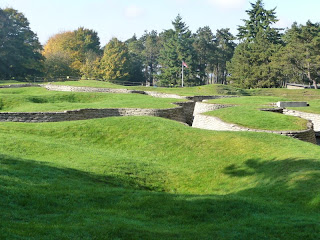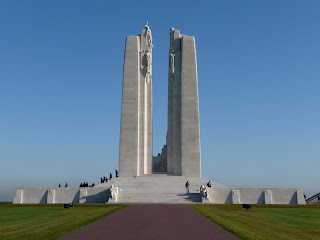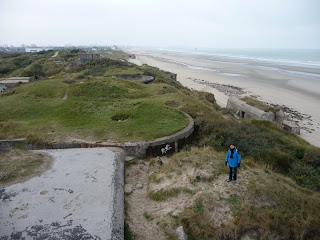This being a family visit, the itinerary was not too ambitious and spread over 3 full days, but allowing a day to travel out and back. Anyway, below is a short summary of the trip, which I hope might help / inspire others to embark upon the path of remembrance.
Monday: Caught the 11 o’clock ferry to Calais.

First stop was La Coupole V2 launching site, near St Omer. OK, not really WW1, but it made a good stopping off point and represents the staggering industrial scale, which the Nazi’s applied to constructing the ‘V’ weapon launching sites against England. The Museum also contains a rather harrowing holocaust exhibition and displays of Allied air missions, in the area. Well worth a visit. Then it was on to Albert, in the Somme, to get something to eat (but no chance of that on a Monday evening in France!?).
Our accommodation was with the really welcoming Sarah and Peter Wright, at Trones View, literally a ‘stones throw’ from Delville Wood. Sarah and Peter could not have made us more welcome and provide a really good English breakfast. We could not recommend them more highly, for a visit to the Somme area. Check out their web site at;
http://www.tronesview.com/
Tuesday: First stop was the Newfoundland Memorial park, near Beaumont Hamel. The park is beautiful and the semi-preserved trench / shell holes, give an excellent feel for the action. The story of the Canadian Newfoundland regiment’s tragic losses and courage is moving.

Next stop was the Thiepval memorial to the 73,000 Commonwealth ‘Missing’ during the Somme campaign. The new visitor centre is very good and the memorial, a very dignified and thoughtful place.

Then it was on to Pozieres. The Australian’s fought hard for this village, as recorded by the 1st Division memorial and the Windmill memorial. Opposite the Windmill memorial, is another memorial commemorating the first use of tanks.


We then moved on to Lochnagar Crater, now a privately owned memorial, showing just what 60,000lb of ammonal can do! After this we called in at Mametz, to get a feel for the nature of the Somme battlefields. From the town cemetery, one can see the Devonshire’s CWG Cemetery and visualise what the German machine gun, sited in the cemetery, could have done to the exposed lines of British troops walking over the crest line in the distance (near the current CWG Cemetery). Even more sad when the British commander had predicted this!?
Wednesday: We said goodbye to Sarah and Peter and headed north, toward Ypres. The plan was to take-in Vimy ridge en-route. It was a sunny day, with a clear blue sky, making the twin sparkling white towers, of the Vimy Ridge Canadian memorial, very beautiful, as well as very moving. The preserved observation trenches and German front line section, complete with shell and mine craters, really brings home the ferocity of the bombardment and reinforces my admiration for the Canadian planning of the operation, to take this hill.


After lunch in Arras, we moved on to the German Cemetery at Neville St Vaast. We were the only visitors and staring out across the 37,000+ burials, even with the sunlight shining through the crosses, was just very sad.

We then moved on down the road, to the Commonwealth cemetery, at Cabaret Rouge. Again we were the only visitors (quite different to Tyne Cot next day!) and even the occasional passing car, does not detract from the sad peacefulness of the place. The large proportion of “unknown soldier of the great war” stones and multiple burial stones, gives on a feel for the brutal nature of the conflict. Our last port of call, before leaving the Arras area, was the French cemetery at Notre Dame Lorette. The chapel and ossuary / lighthouse are very fine buildings and the views from the cemetery, give one a very good idea of the tactical and strategic significance of the two ridges (this and Vimmy ridge opposite).

We then headed off to Varlet Farm, our accommodation for the next two nights. Charlotte Cardoen-Descamps runs Varlet Farm and besides offering a fabulous continental breakfast, excellent accommodation and a vast knowledge of the WW1 sites of the area, is just a really nice person. On her advice we popped into Ypres for the evening ‘last post’ ceremony and a meal in town to follow.

Details of Varlet Farm can be found at;
http://www.varletfarm.com/en/index.htm
Thursday: Now following Charlotte’s plan (in place of mine), we headed off toward Passendale town, marking the peak of the Allied 1917 advance. From Crest Farm and the Canadian memorial, one can appreciate the ‘high ground’ (all 25m of it!!) and the nature of the terrain, which can quickly turn to mud, as it did back then.
We then went on to Tyne Cot cemetery. The new visitor centre is very good and the cemetery itself probably a ‘must do’ (containing nearly 12000 burials (8000 unidentified!) and the wall with over 35,000 names of the missing in the campaign, or for whom there was no room on the Menin Gate!!), it is just that it is a bit ‘busy’.
 After calling in at the Passendale memorial museum (in Zonnebeke) and the local chocolate factory(!), we then called in at Hooge crater. This little private museum (opposite the cemetery), has a very extensive collection of WW1 items and equipment (but just don’t visit on a day with ‘museum fatigue’!). About a 100 yards up the road, is the actual site of Hooge Crater, now a muddy pool in the grounds of a hotel. At the far side of the crater (lake), there are some recreated trenches, Sadly these were flooded, but perhaps gave more of an idea of the famous Passendale mud!?
After calling in at the Passendale memorial museum (in Zonnebeke) and the local chocolate factory(!), we then called in at Hooge crater. This little private museum (opposite the cemetery), has a very extensive collection of WW1 items and equipment (but just don’t visit on a day with ‘museum fatigue’!). About a 100 yards up the road, is the actual site of Hooge Crater, now a muddy pool in the grounds of a hotel. At the far side of the crater (lake), there are some recreated trenches, Sadly these were flooded, but perhaps gave more of an idea of the famous Passendale mud!?It was then on to the Canadian memorial at Vancouver Corner. The ‘Brooding Soldier’ marks the spot where the Canadians and British stood against the first German gas attacks. Our last call of the day was the recreated Yorkshire Trench. This short section of recreated trench, sits somewhat incongruously in the middle of an industrial estate, but gives a good idea of the construction of a typical trench section. Then it was back into Ypres for a spot of shopping and a look at the Menin gate in the daylight.
We would recommend a visit to the First World War battlefields. One can read the books, but only by standing in front of the thousands of graves and having driven through fields, where it is rare to be out of sight of a CWG cemetery, can one get a grasp of the scale of the loss of life and wasted opportunities.
Friday: A relatively short drive back up to Calais, for the early afternoon ferry, was broken by a visit to Dunkirk. The is not much to see of those fateful days in 1940, but standing atop of the crumbling “Atlantic Wall” defences, looking out over the dunes, one can still picture the desperate scenes of the evacuation.
 Phil T
Phil TFurther pictures can be found at;
http://www.flickr.com/photos/phil_t_photos/sets/72157608680424628/

No comments:
Post a Comment